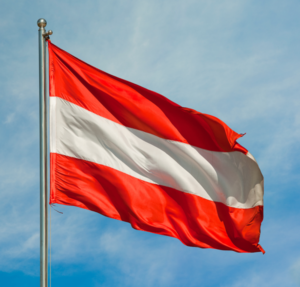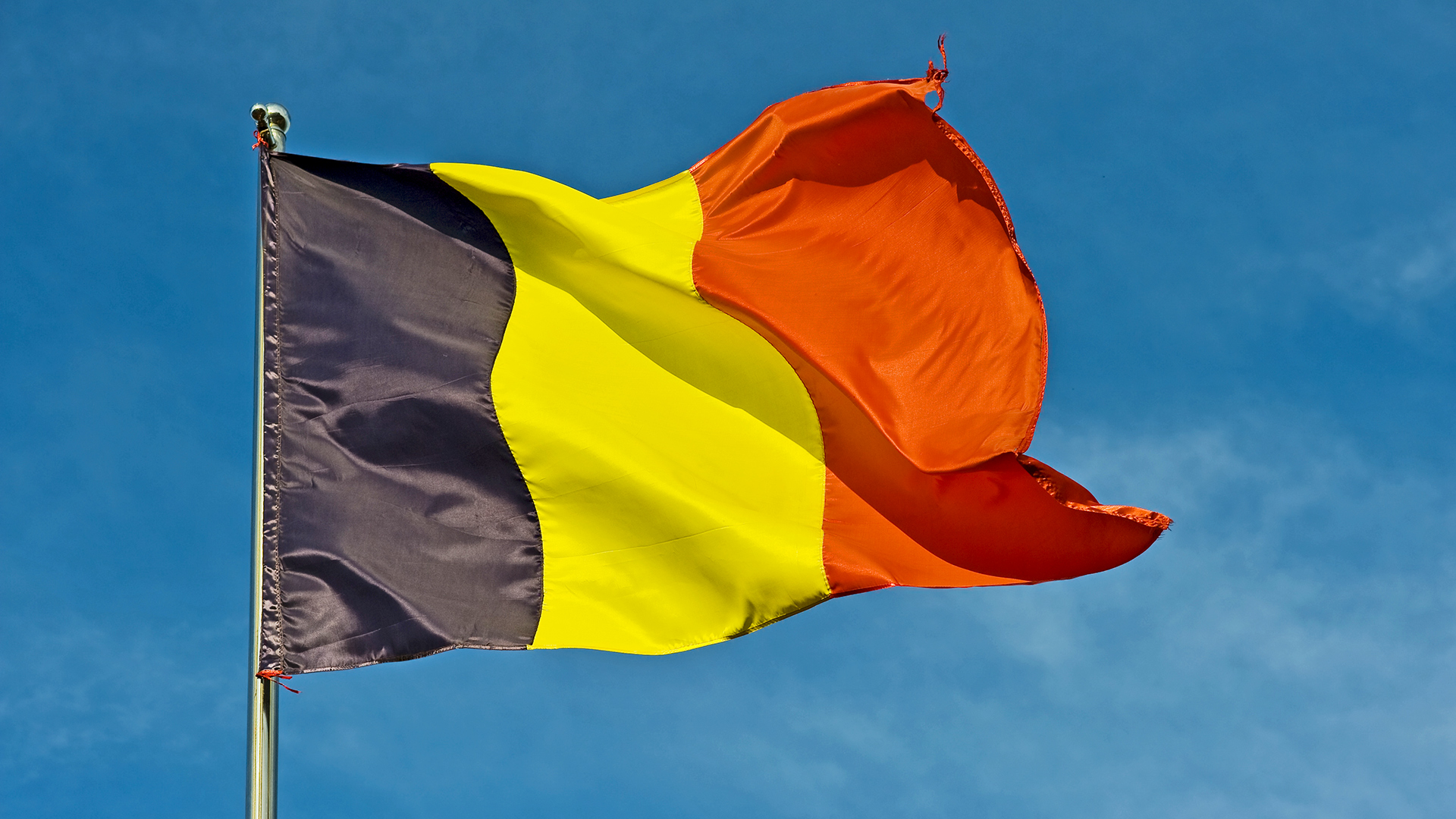
Discover most beautiful historical sites for tourists in Belgium, from charming medieval Bruges to the great castles of Wallonia. Each destination offers a unique glimpse into the country’s fascinating past and architectural splendor.
Here are the top 10 historical sites for tourists in Belgium, each with a brief introduction:
1. Grand Place (Grote Markt)
2. Atomium
3. Gravensteen (Castle of the Counts)
4. Basilica of the Holy Blood (Heilig-Bloedbasiliek)
5. Belfry of Bruges (Belfort van Brugge)
6. St. Bavo’s Cathedral (Sint-Baafskathedraal)
7. Waterloo Battlefield
8. Antwerp Central Station
9. Mont des Arts (Kunstberg)
10. St. Peter’s Church (Sint-Pieterskerk)
1. Grand Place (Grote Markt) Belgium.
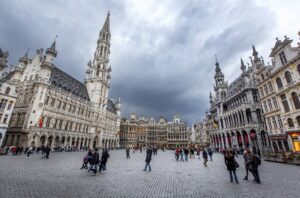
The Grand Place, or Grote Markt in Dutch, is one of the most beautiful historical sites for tourists is the beating heart of Brussels, Belgium, and stands as one of Europe’s most stunning medieval squares.
Surrounded by opulent guild halls, the Town Hall (Hôtel de Ville), and the King’s House (Maison du Roi), the Grand Place is a UNESCO World Heritage site that exudes historical charm and architectural splendor.
The beauty of the Grand Palace attracts tourists as they approach the Grand Palace.
Elegant buildings dating from the 17th century encircle the square, each adorned with ornate facades, gilded statues, and intricate stonework that showcase the city’s prosperous past as a center of trade and commerce.
The focal point of the Grand Place is, indeed, the magnificent Town Hall, a masterpiece of Gothic architecture with its towering spire and intricately carved facade.
Opposite stands the King’s House, which also houses the Brussels City Museum and exhibits the city’s rich history and folklore.
At night, the Grand Place transforms into a magical spectacle with its illuminated buildings and bustling nightlife.
A visit to the Grand Place is a journey through Brussels’ cultural heritage and architectural prowess, offering tourists a glimpse into the city’s vibrant past and present.
Whether exploring its historic buildings, enjoying a Belgian waffle, or simply soaking in the atmosphere, the Grand Place promises an unforgettable experience for visitors of all ages.
2. Atomium Belgium.
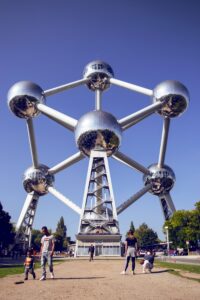
The Atomium, an iconic landmark in Brussels, Belgium, is a striking testament to modern architecture and scientific innovation.
Built for the 1958 Brussels World’s Fair (Expo 58), the Atomium symbolizes the atomic structure of an iron crystal magnified 165 billion times, standing as a representation of progress and optimism in the post-war era.
In addition to approaching the Atomium, tourists are awed by its towering stature—a complex of interconnected spheres and tubes reaching a height of 102 meters (335 feet).
Certainly, the nine spheres, connected by escalators and lifts, house exhibition spaces, a restaurant with panoramic views, and offer glimpses into the history of Expo 58 and the building’s construction.
Each sphere of the Atomium is clad in aluminum and stainless steel, reflecting light and creating a shimmering effect against the Brussels skyline.
For this reason, the structure’s unique design and futuristic appearance have made it a symbol of Brussels and a must-see attraction for visitors.
Inside the Atomium, exhibitions explore themes of science, technology, and culture, often featuring temporary displays and multimedia presentations that engage visitors of all ages.
The permanent exhibition of Expo 58, showcasing memorabilia and photographs from the historic event, occupies one sphere.
Surrounding the Atomium is the Atomium Park, a green space ideal for picnics and leisurely strolls, offering views of the landmark from different angles and perspectives.
A visit to the Atomium allows tourists to delve into Belgium’s cultural and technological achievements while experiencing breathtaking views of Brussels and enjoying a unique architectural marvel that continues to inspire and captivate visitors from around the globe.
3. Gravensteen (Castle of the Counts) Belgium.
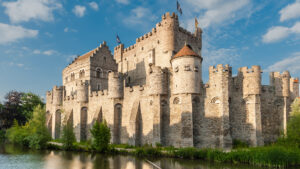
The Gravensteen is one of the most beautiful historical sites, also known as the Castle of the Counts, is a medieval fortress nestled in the heart of Ghent, Belgium, offering tourists a fascinating journey through centuries of history and architectural grandeur.
Built in the late 12th century by Count Philip of Alsace, the castle served as the seat of the Counts of Flanders and a symbol of their power and authority.
Approaching the Gravensteen, visitors are greeted by its formidable appearance—a massive stone fortress surrounded by a moat and accessed through a fortified gatehouse.
The castle’s imposing walls and towers evoke the medieval era, providing a glimpse into the military and political significance it held during its heyday.
Inside the Gravensteen, tourists can explore its well-preserved interior, including the central courtyard where the daily life of the castle’s inhabitants unfolded.
Period furniture decorates the castle’s rooms and chambers while displaying exhibits related to its history and furthermore showcasing weapons, armor, and artifacts that highlight the life and times of the Counts of Flanders.
One of the highlights of a visit to the Gravensteen is, undoubtedly, ascending the castle’s towers, as they offer panoramic views of Ghent’s historic city center and the surrounding landscape.
The rooftop vantage points provide an opportunity to appreciate the architectural splendor of Ghent’s medieval buildings; furthermore, the picturesque River Lys winding through the city adds to the scenic beauty.
The Gravensteen also hosts interactive exhibits and multimedia presentations that bring its history to life, making it an engaging destination for visitors interested in medieval architecture, feudal history, and the cultural heritage of Belgium.
4. Basilica of the Holy Blood (Heilig-Bloedbasiliek) Belgium.
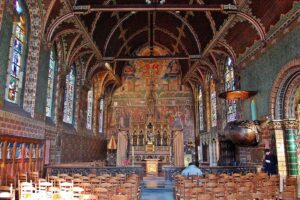
Tourists can explore the Basilica of the Holy Blood, or Heileg-Bloodbasilek in Dutch, which is one of the most famous religious and most beautiful historical sites in Bruges, Belgium, revered for the relics of the Holy Blood of Jesus Christ.
Located in the heart of Bruges’ historic center, this basilica attracts tourists and pilgrims alike with its rich history, architectural beauty, and spiritual significance.
Located in the heart of Bruges’ historic center, this basilica attracts tourists and pilgrims alike, not only with its rich history but also with its architectural beauty and spiritual significance.
Approaching the Basilica of the Holy Blood, visitors are struck by its striking façade blending Romanesque and Gothic styles.
The lower Romanesque portion dates back to the 12th century, while builders added the upper Gothic part in the 15th century, featuring intricate arches, spires, and ornate decorations.
Inside the basilica, tourists can explore two chapels.
The lower chapel, dedicated to St. Basil, is adorned with beautiful murals; moreover, it houses the relic of the Holy Blood, which is believed to have been brought to Bruges after the Crusades.
In other words, the annual Procession of the Holy Blood, a colorful and solemn ceremony dating back to the Middle Ages, parades the relic through the streets of Bruges and is a highlight for visitors.
The Basilica of the Holy Blood also houses a museum showcasing religious artifacts, artworks, and historical documents related to the basilica and the veneration of the Holy Blood.
Surrounded by cobblestone streets and historic buildings, the Basilica of the Holy Blood is, indeed, a cultural and architectural gem, thus reflecting Bruges’ medieval heritage.
5. Belfry of Bruges (Belfort van Brugge) Belgium.
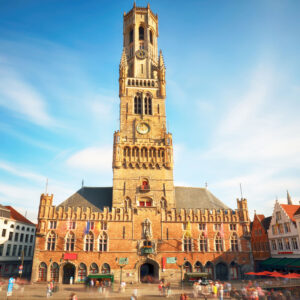
The Belfry of Bruges, known locally as the Belfort van Brugge, is an iconic medieval bell tower that looms over the historic center of Bruges, Belgium. Standing at 83 meters (272 feet) tall, this UNESCO World Heritage site symbolizes the city’s prosperity and independence during the medieval period.
As tourists approach the Belfry, its imposing presence and distinctive octagonal shape topped with a golden dragon weathervane that glints in the sunlight greet them.
Inside the Belfry, tourists can explore the various chambers and exhibitions that, additionally, highlight the tower’s history and significance.
The treasury displays medieval artifacts, while the former meeting room of the city council showcases paintings and sculptures depicting Bruges’ civic pride and cultural heritage.
One of the Belfry’s most famous features is its carillon of 47 bells, which chime melodiously throughout the day, adding to the enchanting ambiance of Bruges.
The bells have been an integral part of the city’s identity since the Middle Ages, signaling important events and celebrations.
A visit to the Belfry of Bruges offers tourists a captivating journey through history, architecture, and panoramic views; thus making it a must-see attraction for those exploring the charm and cultural richness of Belgium.
6. St. Bavo’s Cathedral (Sint-Baafskathedraal) Belgium.
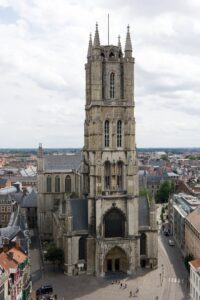
St. Bavo’s Cathedral, or Sint-Baafskathedraal in Dutch, is a majestic Gothic cathedral located in the heart of Ghent, Belgium, renowned for its stunning architecture, rich history, and impressive art collection.
Originally founded in the 10th century and rebuilt multiple times, the cathedral stands as a testament to the city’s religious and cultural heritage.
Approaching St. Bavo’s Cathedral, visitors immediately notice its towering spire and intricate facade adorned with sculpted details and stained glass windows.
The cathedral’s exterior combines elements of Romanesque and Gothic styles, reflecting its centuries-long construction and renovation.
One of the most famous attractions within St. Bavo’s Cathedral is the Ghent Altarpiece, also known as the Adoration of the Mystic Lamb, painted by the Van Eyck brothers in the 15th century.
This monumental polyptych is considered one of the masterpieces of European art, featuring intricate details and vibrant colors that depict scenes from the Bible and Christian theology.
St. Bavo’s Cathedral also houses other notable works of art, including paintings, sculptures, and religious artifacts that provide insights into the cathedral’s history and the religious life of Ghent over the centuries.
Visitors to St. Bavo’s Cathedral can also explore its treasury, which contains a collection of precious religious relics and artifacts, as well as climb the cathedral tower for panoramic views of Ghent’s historic center.
St. Bavo’s Cathedral offers art, history, and spirituality, making it a must-see for those exploring Belgium’s cultural richness.
7. Waterloo Battlefield Belgium.
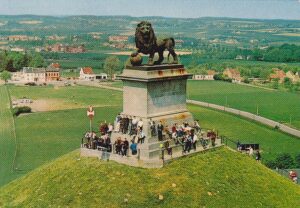
Tourists can explore the Waterloo Battlefield, located near the town of Waterloo in Belgium, which is one of the most beautiful historical sites that marks the decisive Battle of Waterloo fought on June 18, 1815.
This monumental battle, which saw the defeat of Napoleon Bonaparte by the coalition forces under the Duke of Wellington and Prussian Marshal Gebhard Leberecht von Blücher, consequently shaped the course of European history.
Approaching the Waterloo Battlefield, tourists are immersed in the tranquil Belgian countryside, dotted with memorials, monuments, and preserved landmarks that commemorate the events of the battle.
The landscape retains its historic contours, allowing visitors to envision the strategic maneuvers and fierce combat that unfolded across the fields and ridges.
The centerpiece of Waterloo Battlefield is the Lion’s Mound (Butte du Lion), a monumental artificial hill topped with a bronze lion statue.
This iconic symbol overlooks the battlefield and serves as a memorial to the soldiers who fought and died during the battle. Visitors can climb the stairs to the top of the mound for panoramic views of the battlefield and surrounding countryside.
Nearby, the visitor center at the Waterloo Memorial 1815 offers an immersive experience with interactive exhibitions, artifacts, and multimedia presentations that depict the military strategies, personal stories, and political ramifications of the Battle of Waterloo.
Moreover, guided tours and audio guides provide detailed insights into the battlefield’s history and significance.
Throughout the Waterloo Battlefield, visitors can explore preserved farmhouses, defensive positions, and, furthermore, strategic landmarks that played pivotal roles in the battle.
Additionally, interpretive panels and signage provide context and enhance understanding of the battlefield’s layout and historical importance.
Waterloo Battlefield offers a profound glimpse into a key European conflict, reflecting on war’s sacrifices and historical significance.
8. Antwerp Central Station Belgium.
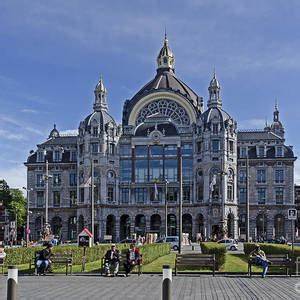
Antwerp Central Station, often hailed as one of the most beautiful train stations in the world, is a grand architectural masterpiece located in the heart of Antwerp, Belgium.
Originally opened in 1905 and renovated extensively in the early 2000s, the station seamlessly blends historic charm with modern amenities, serving as a gateway to both the city and the rest of Europe.
Approaching Antwerp Central Station, tourists are immediately captivated by its stunning exterior façade, characterized by a combination of architectural styles including Art Nouveau and Neo-Baroque.
The station’s monumental dome and clock tower rise majestically above the bustling square, creating an iconic silhouette against the Antwerp skyline.
Inside, Antwerp Central Station impresses with its vast concourse adorned with marble floors, intricate ironwork, and, moreover, a soaring vaulted ceiling.
The main hall, known as the ‘Railway Cathedral,’ features elegant arched windows, chandeliers, and a monumental staircase that leads to the platforms below.
One of the station’s most striking features is the breathtaking railway cathedral, with its ornate iron and glass roof.
Another notable aspect of the station is its integration of modern facilities, including shops, cafes, and a diamond gallery, highlighting Antwerp’s renowned diamond trade.
Visitors to Antwerp Central Station can also explore its underground levels, which include platforms for local and international trains connecting major European cities like Paris, Amsterdam, and Brussels.
A visit to Antwerp Central Station offers tourists not only a glimpse into Belgium’s architectural heritage but also a convenient gateway to explore the cultural richness and vibrant atmosphere of Antwerp and beyond.
Whether marveling at its grandeur or catching a train to your next destination for other parts of Belgium, tourists are sure to be impressed by the station’s beauty and historical sites.
9. Mont des Arts (Kunstberg) Belgium.
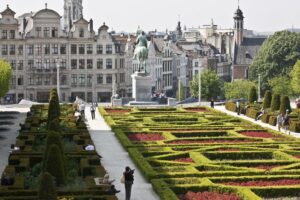
Mont des Arts, or Kunstberg in Dutch, is one of the most beautiful historical sites, a cultural hub and picturesque vantage point in Brussels, Belgium, offering tourists a blend of artistic charm, historical significance, and stunning panoramic views of the city.
Translating to “Hill of the Arts,” Mont des Arts is situated between the historic city center and the royal palace, making it a central and accessible location for visitors.
Approaching Mont des Arts, tourists are greeted by a beautifully landscaped garden adorned with fountains, sculptures, and manicured lawns, creating a serene oasis amidst the bustling cityscape.
Moreover, the garden serves as a tranquil retreat where visitors can relax, enjoy a leisurely stroll, and admire the artistic installations that dot the landscape.
At the heart of Mont des Arts is the renowned Royal Library of Belgium, a striking neoclassical building with a grand colonnaded facade.
The library houses a vast collection of books, manuscripts, and historical documents, making it a haven for scholars and bibliophiles alike.
From Mont des Arts, tourists can ascend the staircase or take the elevator to the elevated terrace, offering breathtaking views of Brussels’ skyline, including iconic landmarks such as the Town Hall, the Atomium, and the spires of Brussels’ medieval churches.
Surrounding Mont des Arts are several cultural institutions, such as the Magritte Museum and the Musical Instruments Museum (MIM), which showcase Belgium’s artistic heritage through exhibitions and interactive displays.
Throughout the year, Mont des Arts hosts cultural events, concerts, and outdoor exhibitions, adding to its vibrant atmosphere and appeal as a cultural hotspot in Brussels.
A visit to Mont des Arts promises tourists a delightful blend of art, history, and scenic beauty, providing a memorable experience and a deeper appreciation for Brussels’ cultural diversity and architectural splendor.
10. St. Peter’s Church (Sint-Pieterskerk) Belgium.
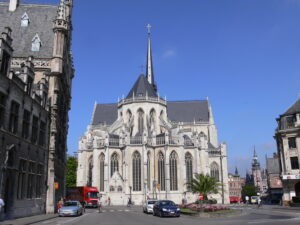
St. Peter’s Church, known as Sint-Pieterskerk in Dutch, is a majestic Gothic church located in the heart of Leuven, Belgium.
Dating back to the 15th century, this historic church is renowned for its impressive architecture, as well as its rich cultural heritage and spiritual significance.
Furthermore, the exterior of the church features intricate Gothic details, including pointed arches, ornate carvings, and delicate tracery that reflect the craftsmanship of its builders.
Inside the church, visitors are greeted by a spacious interior adorned with stunning stained glass windows, vaulted ceilings, and an atmosphere of reverence and tranquility.
Additionally, chapels containing altarpieces, statues, and religious artifacts line the nave and aisles, showcasing the region’s artistic and religious heritage.
Moreover, one of the highlights of St. Peter’s Church is its renowned organ, which was built by the famous organ builder Pieter-Jozef Vereecken in the 18th century.
This masterpiece of musical craftsmanship is still in use today and attracts organ enthusiasts from around the world.
St. Peter’s Church also houses several notable artworks, including paintings by Flemish masters such as Jan van der Elst and Michiel Coxie, which adorn the walls and altarpieces throughout the church.
Visitors to St. Peter’s Church can explore its history and architecture through guided tours and informative displays, gaining insights into its role in the religious and cultural life of Leuven over the centuries.
A visit to St. Peter’s Church offers tourists a glimpse into Belgium’s Gothic heritage, providing a profound experience of art, history, and spirituality in the heart of this historic city.



